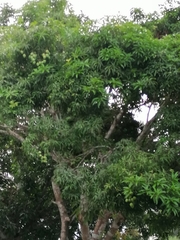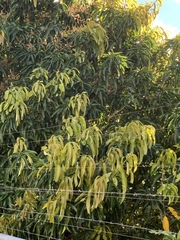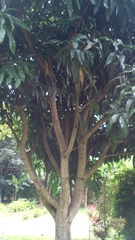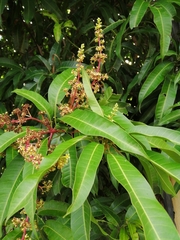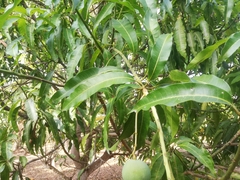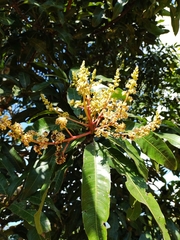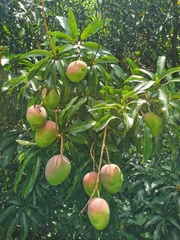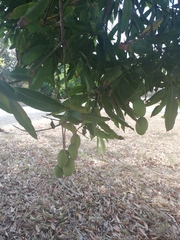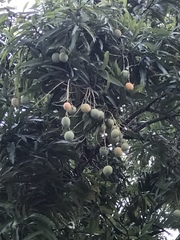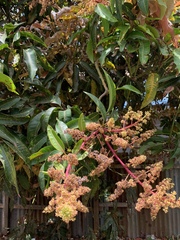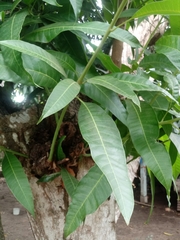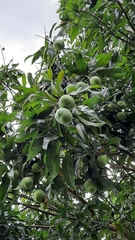

|
|
|
|
Family: Anacardiaceae
mango, more... (es: Mango hilacha)
|
Description: An alien species, one of the best known in the area. A small or medium-sized tree with a short trunk that often branches near the ground. Leaves are long and narrow, very dark green, alternate, but clustered densely at the end of branchlets. Reproduction: Flowers are in dense pyramidal clusters above the leaves, produced during the dry season. Fruits are, well, mangoes - large, single-seeded, with yellow pulp that animals, birds, as well as humans love. Distribution: Native to India, now established throughout the world's tropics. In Panama, an abundant tree of farms and grasslands, sometimes planted, but seeds do germinate and develop on their own. Occasionally occurs in forest, but only in areas that were once farms, or where people frequent. For instance, there are trees in the secondary forest at Barro Colorado, and there are a few along Pipeline Rd. Similar Species: So widely seen it is quickly learned; besides the obvious fruit, leaves are distinctive in the way they are densely clustered at the tip of the branches. Uses: The fruit. Descripción: Árbol de 10 a 25 m de alto. Copa redondeada y con follaje denso. Tronco ramificado a baja altura. Corteza exterior negra o gris, internamente es roja. El desprendimiento de ramas o heridas en el tronco producen una savia resinosa y aromática, la cual se torna roja al oxidarse. Ramitas terminales de color verde. Hojas simples y alternas, de 9-30 x 2-7 cm, oblongas o lanceoladas, con ápice acuminado, bordes enteros a ondulados y base aguda. Las hojas se encuentran agrupadas en los extremos apicales de las ramitas, son verdes y lustrosas, pero cuando jóvenes son de color rosado. Pecíolo de 2-4 cm de largo y pulvinado en la base. Flores amarillentas o ligeramente rosadas, aromáticas. Frutos en drupas, de 8-30 cm de largo, verdes, tornándose amarillos, rojos o anaranjados al madurar. Datos Ecológicos: La especie crece a bajas elevaciones, en lugares secos o húmedos. Ampliamente distribuido y cultivado en Panamá. El mango es nativo del sur de Asia, pero ha sido cultivado como frutal en casi todos los climas tropicales del mundo. Florece y fructifica de enero a julio. Especies Parecidas: En Panamá solo existe la especie M. indica, pero con muchas variedades, lo cual puede observarse en el tamaño, la forma y el color de los frutos. Usos: Es una especie cultivada por el valor nutritivo de sus frutos. Existen muchas variedades que tienen diferentes calidades de frutos, algunos más grandes, con pulpa ácida o dulce. La pulpa de los frutos maduros es comestible y se emplea para preparar jaleas, conservas y jugos. Los frutos verdes tienen un aceite resinoso que es irritante y cáustico, el cual puede ocasionar fuertes irritaciones al contacto con la piel. La madera es fuerte y pesada, en muchos lugares del interior del país se emplean pedazos del tronco para cortar las carnes en las carnicerías. Las hojas, las flores y la resina son utilizadas en la medicina tradicional. Tree to 40 m tall, to 1 m dbh; sap milky; stems and leaves glabrous. Leaves simple, alternate, dense at apex of branchlets, more widely spaced below; petioles 1-6 cm long; blades mostly oblong, acute to long-acuminate, cuneate at base, 9-35 cm long, 2-7 cm wide, often undulate. Panicles terminal, 20-50 cm long; flowers bisexual, 5-parted; sepals ovate, to 3 mm long; petals greenish-white, +/- oblong, to 5 mm long; stamens 5,1 large and fertile, the other 4 reduced to staminodia; ovary obliquely subglobose or the style eccentric, slender, about equal to fertile stamen. Drupes oblong or semireniform, 10-20 (30) cm long, greenish-yellow or orange at maturity; mesocarp thick, juicy, yellow or orange; seed oval, flattened. Croat 5435, 7107. Touching these plants, especially the fruit, causes some people to be poisoned in the same manner in which they are from poison ivy (Blohm, 1962). Bocas Species Database Habitat: Mango trees grow well in subhumid-equatorial to subarid-subtropical regions because they cannot tolerate frost. Very high temperatures are not good as well and therefore the optimum temperature is 25°C. A single mango tree can be found at altitudes of up to 1200 m, but generally, an mango orchard will not be placed at an altitude higher than 600 m. The quality of the soil is not so important for mango trees, but very poor soils should be avoided. Distribution: The mango is native of India or the Burma-Malesian region. Mangos were introduced to Brazil and the West Indies during the 1700s and to Europe in the 1800s. It is now introduced in every tropical and subtropical country in the world. Natural History Notes: Mangos are very popular and mostly known for their delicious sweet taste and their fibrous texture. But what is maybe less known is that mangos can have toxic properties. The leaves, the sap, the green fruit and the skin of the ripe fruit contain an allergic agent called 3-pentadecyl catechol. A person sensitive to poison ivy will probably react stronger to the resin of mangos. However, it is important to understand that people usually develop an allergic sensitivity to the resin and not to the fruit in itself. One may enter in contact with the resin while holding the fruit and having a scratch, or by simply climbing a mango tree where resin has been liberated. This is why it is important to rinse the fruit to remove the sap present on it. Some symptoms of contacts with the sap include itching rash, and swelling. The rash and the swelling may be located around the eyes and the mouth, in the case of an excessive consumption of mangos. However, this should not prevent you from enjoying the beneficial uses of mangos. It is one of the most popular tropical fruits and is rich in nutrients. It contains several essential vitamins, such as vitamins A, C and E, and 17 different amino acids. The pulp of a mango is also rich in the pigment antioxidants carotenoids and polyphenols, as well as omega-3. And the list goes on and this is why mangos are called “super fruits”. Characteristics: The mango is a large, straight, evergreen tree that can reach a height of 30 meters. The crown (leaf foliage) is fairly dense and has a round shape. The mango tree is defined as a "survivor" because of its long lifespan. Some specimens have been reported to be 300 years old and could still flower! The leaves are oval shaped and spirally arranged, and they are first red colored, but eventually turn green. The mango tree will produce inflorescences that will each contain thousands of small, yellow or red flowers, among which 25-98% are male flowers and the rest are hermaphroditic flowers. The mango fruit is generally rounded to oval shaped, but the size and the shape can vary greatly. The skin of the fruit has a smooth, waxy texture and its coloration shows different gradients, varying from light green to orange-red as it matures. The inside of the fruit is composed of the edible yellow-orange pulp (mesocarp) that has a fibrous texture and that is juicy and sweet. There is also an oval shaped woody stone (endocarp), which encompasses the seed, monoembryonic. |












